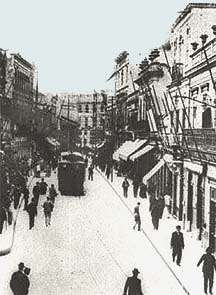The Boeuf chronicles, Pt. 21
And now for something slightly classical.
10 August 2002
Alexandre LevyDuring his close to two years in Brazil, Darius Milhaud observed many aspects of the country’s music. In his unpublished article Bresilien Music [sic], written at Mills College in 1942 or ’43, Milhaud described various popular musical genres and their origins, as well as the work of erudite composers such as Carlos Gomes, Alberto Nepomuceno, Henrique Oswald, Francisco Braga, Glauco Velásquez, Luciano Gallet, Villa-Lobos, Francisco Mignone, Oscar Lorenzo Fernandes, Radamés Gnattali, and Camargo Guarnieri.
Of the above mentioned composers, only one (Nepomuceno) is quoted in Le Boeuf sur le Toit, but his is by no means the only “serious” composition borrowed by Milhaud. Although Milhaud never mentioned Alexandre Levy by name, he used his most famous work in the rondo.
Rua 15 de Novembro, where Casa Levy
was locatedTune No. 21: “Tango Brasileiro” (1890)
Alexandre Levy (1864–1892) was a composer, pianist, conductor, and music critic who lived in São Paulo, where he died at the age of 27. His father was the French clarinetist Louis Levy, who settled in São Paulo four years prior to Alexandre’s birth and founded the musical instrument store Casa Levy, an important gathering place for the city’s musicians and artists. A child prodigy, Alexandre began playing in public at the age of eight and was compared to Mozart by the music critics of his time. He studied in Paris and traveled in Europe, and his output included orchestral, chamber, and instrumental solo music. Levy’s mature compositions showed marked nationalist traits, incorporating themes from folklore and urban as well as rural popular tunes.
A biographical text published by Brazil’s National Library points to the nationalist discourse that dominated the late 19th century—a time when slavery was abolished and the Republic was declared—as the engine that propelled nationalist music. The text focuses attention on Levy and Alberto Nepomuceno, quoting Mário de Andrade:
E realmente são estes dois homens [...] as primeiras conformações eruditas do novo estado de consciência coletivo que se formava na evolução social da nossa música, o nacionalista.
In his Web page dedicated to Alexandre Levy, Nando Florestan provides the following information about the composition:
Tango Brasileiro was published in 1890 in the newspaper O Diario Popular “as a gift to our graceful readers.” This was of course a reference to the young ladies, who were supposed and indeed used to play the piano. But the sympathy of the Tango has transcended those nineteenth-century interpreters and the piece is now standard Brazilian repertoire. Guiomar Novaes, Antonieta Rudge and Eudóxia de Barros are some of the pianists who have recorded it.
Levy’s Tango alternates constantly between A major and A minor. The ending chord in A minor is unexpected, since the last section is in A major—just the opposite of the Baroque custom of ending pieces written in a minor key with a major chord.
Eudóxia de Barros and Osvaldo LacerdaFundação Joaquim Nabuco’s database of 78-rpm recordings lists only one of “Tango Brasileiro,” recorded by none other than Aloysio de Alencar Pinto, principal identifier of the Boeuf tunes:
Autor: Alexandre Levy
Título: Tango Brasileiro
Intérprete: Aloisio Pinto (piano)
Gravadora: Victor
Número: 87.5518-A
Matriz: B3VB0323
Data gravação: 03.12.1953
Data lançamento: Mar/1954We’ll compare section B of “Tango Brasileiro” as it is quoted by Milhaud at 11:20 min. into Louis de Froment’s recording of Le Boeuf sur le Toit,
with an excerpt from Eudóxia de Barros’ recording of the original composition.In a final appearance, the opening of “Tango Brasileiro”
serves as the closing of Le Boeuf sur le Toit, where it appears twice, following the 14th and the 15th reiterations of the rondo theme.
Copyright © 2002–2016 Daniella Thompson. All rights reserved.






